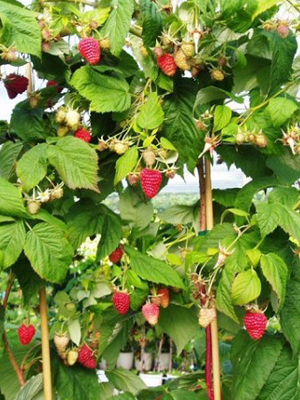Sections of the site
Editor's Choice:
- Business with China - where to start, how to find suppliers + TOP-15 goods from China and a list of trading platforms
- Where to invest 1000 dollars
- Three common misconceptions and six life tips
- How can maternity capital be used - what needs can be spent on maternity capital
- Caramel apples - a new idea for business
- Ready business plan for beginners
- Gypsum tiles for stone: 7 advantages of the material
- How to buy the best and interesting unusual goods from China for home, gifts and sales on Aliexpress in Russian?
- Business plan for opening a bath
- Where to spend maternity capital before the child is 3 years old
Advertising
| Industrial cultivation of raspberries as a business |
|
0 Growing raspberries is interesting and promising. Amateur gardeners, having mastered small areas with remontant varieties, by trial, experiment and error, then expand their plantation. Ultimately, on a personal plot, you can establish an off-season business, growing tender and tasty berries for sale. The raspberry contains: glucose, fructose, fiber, pectins, B vitamins, carotene, folic acid.
12 landmarks for starting a business
The choice of a variety is the key to successDefinitely, the cultivation of raspberries in the country begins with the choice of its type. There are only two of them:
Today, breeders have bred new varieties of raspberries without thorns, with heat, frost and drought resistance, less susceptible to diseases and pests, with excellent transportability. There are large-fruited (the fruit weighs 10 g), 4-5 kg are harvested from one bush per season. A wide selection of varieties with different ripening periods will allow you to pick berries all season.
Repaired raspberry varieties for industrial cultivation delight with the harvest already in the year of planting. Among them are famous "Brusnyava", "Phoenix", "Polana" and "Polka", "Octavia", "News of Kuzmina" and "Tulamin". Their berry is fleshy and dense, does not wrinkle and does not flow, when ripe and at the time of collection does not crumble. The varieties of "Gusar", "Lyachka", "Patricia" and "Hercules" have taken root in the car business. Raspberry farming technologiesGardeners use different methods of growing raspberries, they are very different in terms of labor intensity, but equally effective. We propagate raspberries with seedlingsFor their better rooting, before planting, they are soaked for two hours in a solution of the rooting agent - Kornevin or Heteroauxin. And so that the roots do not rot, you can add the systemic fungicide Quadris or Ridomil to the solution. The bushes should be planted in trenches about a meter wide, at a depth of up to 35 cm. We add compost or humus to the bottom. If there are 2-3 rows of plants, the distance between the trenches is not less than 170 cm, between the seedlings - half a meter so that the rhizome develops well, and they are covered with nutritious soil to the level of the root collar. The technology of growing raspberries involves cutting off the planted bushes, leaving shoots up to 20 cm to form a strong bush. After planting, watering is required (calculation - 5 liters of water per plant). The final stage of planting is mulching the soil with rotted manure or peat. Growing raspberries with seeds It is worth considering that growing raspberries from seeds is real, but only half of the planted material will germinate. We take a ripe berry, even better - overripe. We squeeze the juice through a fine strainer, the pulp in the container is poured with cold water and mixed. We discard the floating empty seeds, repeat the washing 4 times. We dry the seeds in a ventilated and warm place, protecting them from direct sunlight. The secrets of growing from seeds are different for everyone. Some of them are sown in the fall - the depth of open ground is 2 cm, covering with a mixture (in equal parts, they take humus and sand). Others - in the spring, germinating seeds in seedling containers. The soil is prepared from peat, sand and garden soil (in equal proportions), which is sown (depth 4-6 mm). Regularly watered - with clean water every 4 days once and with a solution of urea three times a month. Planting seedlings of raspberry seedlings, sprouted from seeds, in open ground as usual. Cooking raspberry cuttingsThe technology of breeding raspberries allows cuttings to be carried out in spring or autumn, based on the vegetative state of the plants. In the spring, green cuttings are used to propagate the bush you like. It is very profitable to grow by cuttings for breeding remontant varieties of raspberries.
Further cultivation of raspberry seedlings is carried out in a light and nutritious soil mixture - in a greenhouse or greenhouse. They are regularly sprayed, fed with solutions of trace elements, and rooted ones are planted in open ground in a permanent place. By the fall, powerful raspberry bushes will grow, which will bear fruit the next year. Autumn cuttings are cultivation by roots or cuttings using root suckers, root cuttings and woody cuttings. You need to know its features:
Growing raspberries according to the Sobolev method
This technique promotes the formation of a bush, the growth of the remaining branches is enhanced, and facilitates the gardener's care. In addition, Sobolev mulches the beds with fresh cow or horse manure, watering them several times. The resulting crust retains moisture, gradually decomposing and enriching the soil. Raspberries on a trellisModern varieties of raspberries are quite high - 1.8 m. Their fruit branches lean to the ground during the ripening period. There is a way out - growing on a trellis (poles with stretched wire in several rows). Depending on the variety and density of planting in raspberries planted in rows, one - and two-lane, V -, T - and Y-shaped or hipped horizontal trellis are used. The benefits of this are obvious:
Once erected, the trellis will serve the owner for several years. Agrotechnical components of raspberry cultivation
Considering that the raspberry bush lives for about 8-12 years, it is necessary to constantly update the plantation. One hundred square meters usually grows 40 bushes, although some farmers plant 70,000 bushes on one hectare. The rows are oriented to the north. Classic density - 4 seedlings per running meter. Full care for raspberries includes dosed drip irrigation to the very root (water overruns can be avoided); pest control (gall midge and other suckers, strawberry-raspberry weevil and raspberry beetle, raspberry stem fly) and diseases - nematode, anthracnose; purple spot and curl raspberry. Collection and storage of raspberriesIt is worth picking berries 2 days before maturity, the line between ripe and overripe is invisible. Overripe fruits lose transportability. It is optimal to start (if there is no dew and dry weather) at 4-5 in the morning and end the collection at 10-11 hours .. 2-3 days before that, it is better not to water the raspberries. Fully ripe berries are removed from the fruit for local consumption. For long-distance transportation, it is better to collect slightly immature ones. It is convenient to collect raspberries for sale in shallow containers from 0.5-2 kg, for processing - you can also in buckets. In recent years, berries harvested from a receptacle have been in demand on the market. They are trimmed with scissors or pinched off. The price for such products is higher. It is undesirable to sprinkle raspberries after collection. It is advisable to immediately collect it in containers for sale. The berries are sold in plastic containers with a volume of 250-400 g. Plastic blisters (an economical option), neat veneer baskets (more expensive), birch bark barks or cardboard boxes are suitable. The economic feasibility of growing raspberriesConsidering the industrial cultivation of raspberries as a business, we can conclude: the raspberry business is profitable. But in the first year of fruiting, you should not expect 100% profit. This is pure populism. After all, you need to calculate everything: what you spent, how much you paid, take into account the prices of planting material (in the first year, 70% of the total budget will be spent on this), mulch, chemical protection and fertilizers, the cost of watering and heating the greenhouse. To determine the profitability of growing raspberries, you need to calculate the cost of 1 kg of products, perform a calculation taking into account the costs of growing, salaries of employees, and transportation costs. We compare expenses with income, deduce profits and make an analysis for the future: how to continue doing business. If the cultivation of raspberries in a greenhouse is established all year round, then by choosing good varieties and conscientiously caring for raspberries, you can recoup the costs in 2 seasons. Many entrepreneurs, in order to increase profitability, combine the cultivation of berries in greenhouses and in the beds. By properly organizing the business and solving all sales problems, you can achieve its profitability at the level of 65%. Probably worth a try! |
| Read: |
|---|
Popular:
Power and energy measurement
|
New
- Where to spend maternity capital before the child is 3 years old
- What business can you do at home
- How to open a sauna (bathhouse): business plan and recommendations
- Private bath and sauna as a business idea
- Natural stone business
- Fusing glass at home
- Power and energy measurement
- How to get promoted to a novice beauty master
- Breeding of laying hens for eggs: business plan and profitability
- Creative business ideas that make a profit

 Many are attracted by plants of Polish, Scottish selection, American and Canadian varieties, but we must not forget that for a good return they need intensive care and winter shelter. And the weather conditions in the Urals or Siberia are incomparable with those that occur abroad.
Many are attracted by plants of Polish, Scottish selection, American and Canadian varieties, but we must not forget that for a good return they need intensive care and winter shelter. And the weather conditions in the Urals or Siberia are incomparable with those that occur abroad. AG Sobolev is called "the crimson Michurin". He developed and improved his own method, which brings about 6 kilograms of berries from each bush. Sobolev's method consists in double pruning of raspberries. Growing only six bushes of raspberries, it is possible to provide a family of four with a berry (for food and preparations for the winter).
AG Sobolev is called "the crimson Michurin". He developed and improved his own method, which brings about 6 kilograms of berries from each bush. Sobolev's method consists in double pruning of raspberries. Growing only six bushes of raspberries, it is possible to provide a family of four with a berry (for food and preparations for the winter).  The correct agricultural technique for growing raspberries is a chance to grow a bountiful harvest. It involves the choice of a site (sunny areas are suitable for a raspberry tree and protected from the winds). The soil is important (medium loamy light nutritious soils, acidity in the range of pH 5.8-6.7). The application of mineral fertilizers to frozen soil in early spring has a positive effect.
The correct agricultural technique for growing raspberries is a chance to grow a bountiful harvest. It involves the choice of a site (sunny areas are suitable for a raspberry tree and protected from the winds). The soil is important (medium loamy light nutritious soils, acidity in the range of pH 5.8-6.7). The application of mineral fertilizers to frozen soil in early spring has a positive effect.



